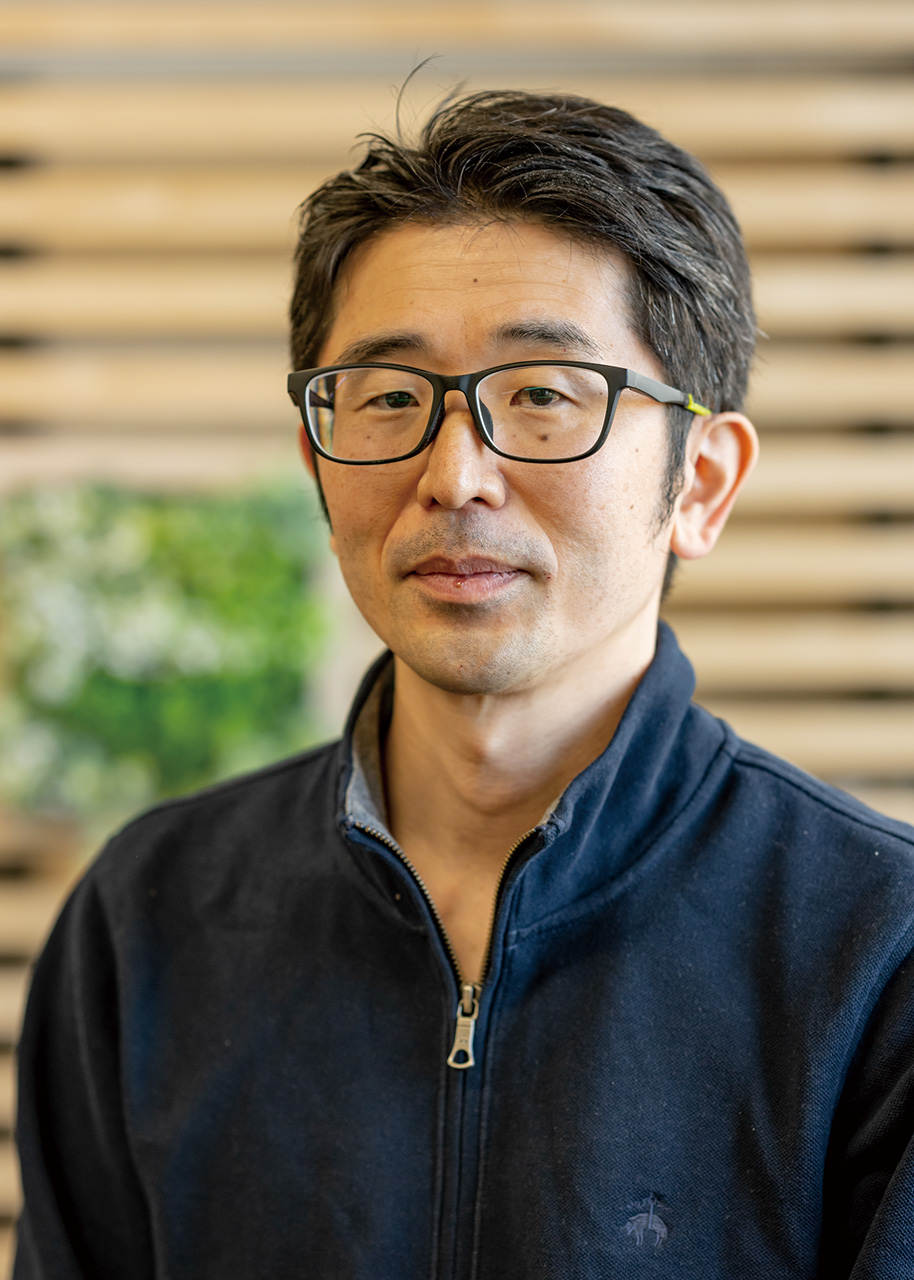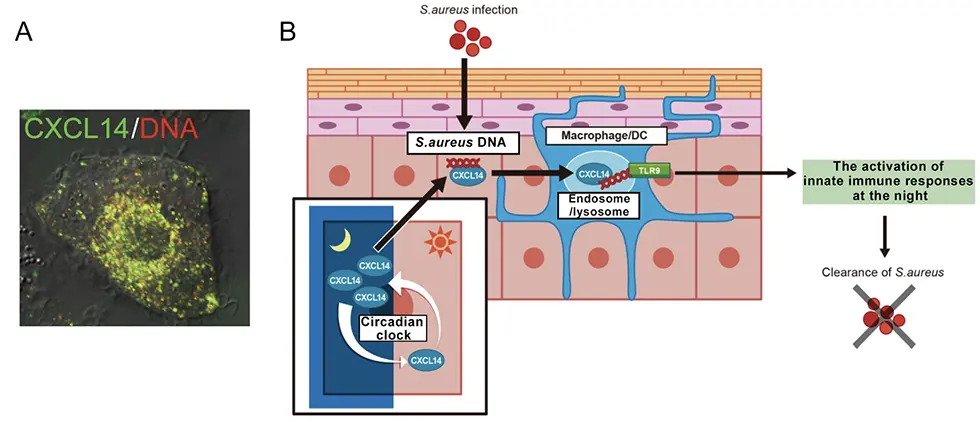Meet our scientists!
 BackTopics Page
BackTopics Page
A lot of research has focused on antibodies and adaptive immunity, especially recently because of the coronavirus pandemic. However, innate immune responses are also fascinating to study. They attack foreign invaders very quickly although they have less specificity than antibodies. Recently, Kosuke Tanegashima, a staff scientist in the Stem Cell Project, led by Takahiko Hara, identified a novel innate immunity mechanism that is regulated in a circadian manner. Immune responses are greater during an animal’s subjective nighttime, when they are inactive, compared to their subjective daytime, when they are active. His work was published in a paper, “Circadian protection against bacterial skin infection by epidermal CXCL14-mediated innate immunity,” in the Proceeding of the National Academy of Science, USA (Proc Natl Acad Sci U S A. 2022 Jun 21;119(25):e2116027119. doi: 10.1073/pnas.2116027119. Epub 2022 Jun 15). We spoke to him about his interest in science, his research, and why he thinks it makes sense for some immune responses to be regulated in a circadian manner.

How did you first become interested in science?
I’ve been interested in science for as long as I can remember. My father used to grow plants and crops in our backyard, and when I was a child, I dug up these plants to see their roots and flower bulbs. I wanted to see how plants grow and develop. I think this initial interest led me to pursue developmental biology using molecular biology in college and postdoctal study. I later switched to studying immunology since I thought molecular biology that I learned could be applied to the medical sciences. My current work on CXCL14 is particularly interesting to me since it has both medical implications and involves elucidating novel mechanisms of activation of innate immune responses.
Could you explain your recent work on innate immune responses?
In our paper, we describe a novel innate immunity mechanism that the epidermis uses to recognize proliferation of Staphylococcus aureus. S aureus is a bacterium that is normally found on the skin, but it can become pathogenic, causing infections and diseases under a certain circumstances. We were studying a chemokine called CXCL14. Chemokines are small, secreted proteins that cause inflammation by recruiting immune cells to sites of infection or injury. However, even though I tried for a long time, I just couldn’t detect inflammatory responses when I added CXCL14 to cultured cells. So, I thought that there may be some cofactor that needs to bind to CXCL14 to induce inflammation. Since CXCL14 is a highly basic protein, I thought this cofactor could be DNA, which is acidic. This idea turned out to be correct, and we found that CXCL14 collaborates to certain types of DNA, and this binding is needed to cause inflammation and activate innate immune responses. Interestingly, CXCL14 collaborates to S aureus DNA but not E coli DNA. S aureus is found mainly on the skin, while E coli is found mainly in the gut, so CXCL14 binding specificity could have evolved to predominantly recognize DNA from bacteria found on the skin.
How is this innate immune response regulated by circadian rhythms?
Dr. Hitoshi Okamura’s group at Kyoto University independently found that CXCL14 is expressed in the skin in a rhythmic, circadian fashion, but he didn’t know its function. When we found out about each other’s work, we decided to collaborate, and we discovered that CXCL14 induces inflammation and immune responses to S aureus infections in a circadian manner. Mice are active during the night and sleep during the day, while marmosets are active during the day and sleep during the night. In mice, CXCL14 is high during the day when they are inactive and low during the night when they are active. Similarly, CXCL14 is high at night in diurnal marmosets when they are asleep and low during the daytime when they are active. We found that mice are more resistant to infection by S aureus during the day when CXCL14 is high compared to the nighttime when CXCL14 is low. Similarly, we’d predict that diurnal animals including human should be more resistant to S aureus infections at night compared to daytime.
That’s fascinating! Why do you think immune responses oscillate in a circadian manner?
We haven’t proven this, but this is what I think. We have a limited amount of energy. When we are awake, we participate in many activities that require a lot of energy, such as running or thinking or digesting. Immune responses also require a lot of energy. When we are resting, we don’t have to use energy for activities such as searching for food, eating, or running, so energy is available for immune responses. So, I think it’s reasonable that during subjective nighttime, energy is directed toward activities such as tissue repair and immune responses. For really severe infections where you sleep during the day, maybe other mechanisms besides CXCL14 compensate to increase immune responses during normally active times.
What do you plan to do in the future?
I'm very interested in understanding how cells sense DNA. DNA is a very common substance, and represents the nature of living organisms. But we don’t know how immune cells recognize and deal with DNA. It’s a completely unknown field. So far, I’ve found that CXCL14 binds to S aureus DNA, and this CXCL14 DNA complex is somehow recognized by immune cells to induce immune responses. However, we don’t know what receptor recognizes this CXCL14-DNA complex. I’ve been looking for this receptor by screening using expression cloning and I’ve found several candidates that I’m excited about studying.

A(A) A fluorescent image that shows CXCL14/DNA complexes incorporated into dendritic cells. (B) A schematic model of circadian clock-mediated clearance of S. aureus by CXCL14. Expression of the Cxcl14 gene in epidermal keratinocytes is regulated by circadian rhythms. When S. aureus invades skin keratinocytes, CXCL14 binds to bacterial DNA and transports it into dendritic cells (DCs) and macrophages to activate innate immune defenses against the bacteria.
Interviewed by Jun Horiuch